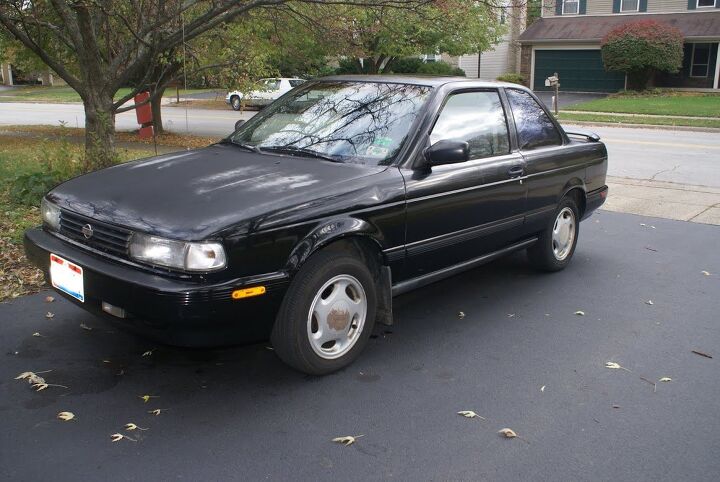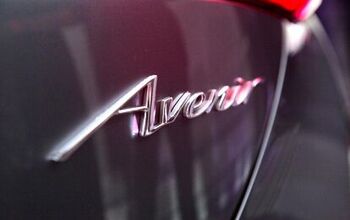Foreign Affairs: Nissan Tsuru, Mexico

As wonderful as the American marketplace is, there’s an entire world — literally — of cars out there that we just can’t get our hands on. In TTAC’s new series, “Foreign Affairs,” we look at forbidden fruit that you can buy brand new around the world.
The Mexican new car market is remarkable. While plenty of good new cars come across the border, inciting at least one presidential candidate to threaten penalty taxes, its domestic market still continues to sell older gems, some of which are built to older safety standards. Even the Beetle was built there long after its sell-by date.
The car that fascinates me, naturally, is one I’ve previously owned: the Nissan B13-chassis Tsuru, known here in the U.S. as the 1991-94 Nissan Sentra.
The Tsuru is popular most likely due to its bargain basement cost. A basic model can run as low as $7,040 USD after promotional savings. I’m sure the model’s long lifespan has also contributed a massive secondary market in parts and spares, as this has been used as a taxi all over the country for years.
I doubt it’d be a good Uber ride, though.
Only a few major changes have been made over the years — primarily some restyling of the grille and headlamps. The option packages look a bit different than what we would typically see here, as well. The base model doesn’t offer air conditioning or power steering, but has a standard anti-theft alarm and remote unlocking. While the base 1.6-liter engine won’t be particularly quick, its light weight will at least make it nimble.
I still wish Nissan would offer something like this — since we know they will still build the basic car — with some performance features like the big SR20 engine, and sell it here in the U.S. As worn out as my 1991 SE-R was, it was still more fun to drive than any current, smaller car from Nissan.
[Images: Tsuru, Nissan Mexico; Faded Sentra, © Chris Tonn/The Truth About Cars]
Chris Tonn is a broke classic car enthusiast that writes about old cars, since he can’t afford to buy them. Commiserate with him on Twitter, Facebook, or Instagram.

Some enthusiasts say they were born with gasoline in their veins. Chris Tonn, on the other hand, had rust flakes in his eyes nearly since birth. Living in salty Ohio and being hopelessly addicted to vintage British and Japanese steel will do that to you. His work has appeared in eBay Motors, Hagerty, The Truth About Cars, Reader's Digest, AutoGuide, Family Handyman, and Jalopnik. He is a member of the Midwest Automotive Media Association, and he's currently looking for the safety glasses he just set down somewhere.
More by Chris Tonn
Latest Car Reviews
Read moreLatest Product Reviews
Read moreRecent Comments
- MaintenanceCosts Nobody here seems to acknowledge that there are multiple use cases for cars.Some people spend all their time driving all over the country and need every mile and minute of time savings. ICE cars are better for them right now.Some people only drive locally and fly when they travel. For them, there's probably a range number that works, and they don't really need more. For the uses for which we use our EV, that would be around 150 miles. The other thing about a low range requirement is it can make 120V charging viable. If you don't drive more than an average of about 40 miles/day, you can probably get enough electrons through a wall outlet. We spent over two years charging our Bolt only through 120V, while our house was getting rebuilt, and never had an issue.Those are extremes. There are all sorts of use cases in between, which probably represent the majority of drivers. For some users, what's needed is more range. But I think for most users, what's needed is better charging. Retrofit apartment garages like Tim's with 240V outlets at every spot. Install more L3 chargers in supermarket parking lots and alongside gas stations. Make chargers that work like Tesla Superchargers as ubiquitous as gas stations, and EV charging will not be an issue for most users.
- MaintenanceCosts I don't have an opinion on whether any one plant unionizing is the right answer, but the employees sure need to have the right to organize. Unions or the credible threat of unionization are the only thing, history has proven, that can keep employers honest. Without it, we've seen over and over, the employers have complete power over the workers and feel free to exploit the workers however they see fit. (And don't tell me "oh, the workers can just leave" - in an oligopolistic industry, working conditions quickly converge, and there's not another employer right around the corner.)
- Kjhkjlhkjhkljh kljhjkhjklhkjh [h3]Wake me up when it is a 1989 635Csi with a M88/3[/h3]
- BrandX "I can charge using the 240V outlets, sure, but it’s slow."No it's not. That's what all home chargers use - 240V.
- Jalop1991 does the odometer represent itself in an analog fashion? Will the numbers roll slowly and stop wherever, or do they just blink to the next number like any old boring modern car?
































Comments
Join the conversation
.
For those who admire the Tsuru, damn the safety aspect, I feel your pain. No, its not as safe as new cars, okay, but it represents a good car no matter that, and its still popular and being manufactured and sold today. I am not a huge fan of the Nissan Sentra. I had a 1985 coupe and drove several of the 1990s bodystyle this one still is. Its not my nirvana of compacts, and I much prefer the two door (never drove the SE-R) if I was to have one, but I more than understand yout desire to have access to the Tsuru. Lets be honest, by the time a 2016 Tsuru is 25 years old and thus eligable for import by non-Mexicans, itll be older and in far worse shape than this: http://seattle.craigslist.org/see/cto/5482833919.html Personally, I like the silver wheels, but for $7-8k, you could build a new car from that. Rebuild/replace/upgrade? the drivetrain, body, paint, interior done to your specs (vinyl and rubber or leather and carpet with sound deadner). Get the updated Tusuru grille, headlamps, etc from Mexico. I like it, itd look sweet. I also like the F-150 (V-6) and F-250 (V-8) trucks they built all through the late 2000s after the model (which did poor in crash tests, with airbags) was replaced in 2004 in the US (continued as Heritage for one year). It got an updated grille and headlamps that would look amazing on a 97-03 F-150, 97 F-250 light duty or first gen Expedition. I love the little Fiesta-based Courior coupe-utility (not based on the current Fiesta we get), although I think its out of production and has no hope of entering the US for our consuption anytime soon. Latin America is a haven for forgotten US cars and trucks. Ford Falcon in Argentina until 1991! 1968-72 F-series in Brazil until the 1990s as well. Both with updated styling Im envious of. Cars like the Chevy Opala and Ford Landau put the similar-sized US models to shame. GM's Chevy Inline 6 contined so long, it got a Vortec head and was put in Tahoes, Suburbans and pickups until the late 90s at least! I would love to get my hands on it! AVortec Inline 6 based on the bullet proof early 6's and not the crap that was in the Trailblazer? Yes! There is an early 1990s Chevy Suburban K1500 not far from me, Chevy 350 engine sat with water in it. Interior vinyl and rubber. Flat green exterior. 4Wd, off road tires, 3" suspension lift, good trans/case/rear. Id put that Vortec Inline 6 in there and love it! No it wouldnt be fast, itd be great at what I want. Fast is for something not the size of a studio apartment. The point is, there is a tresure of awesome American (and non-American including American branded) cars and products out there.